Great Northern Arts Festival
The GenoGraphic Project








IFA 25th Anniversary Celebrations



Great Northern Arts Festival
The GenoGraphic Project








IFA 25th Anniversary Celebrations























Photos by Maia Lepage and Shayne Cockney 34 The High Side of Rafting the Firth River
Words by Rachel Hansen, Photos courtesy of Parks Canada
36 40th Annual Circumpolar Games




Words and Photos by Maia Lepage and Ryan
Lepage
46 Young Researchers:
Words by Jocelyn Noksana and Ryan Walker 48 The Sound of the Soul: Leanne Goose
Words and photos by Maia Lepage 52 Recipe: Muskox Stirfry
Tusaayaksat is Inuvialuktun for “something new to hear about.” Volume 22, Number 8 . Published quarterly by Inuvialuit Communications Society at 292 Mackenzie Drive, Inuvik, NW Territories, Canada. For advertising and subscription inquiries, please email us at tusaayaksat @ northwestel.net or call 867 777 2320
Publisher Topsy Cockney, Inuivaluit Communications Society Executive Director
Editor/Writer/Creative Dir. Maia Lepage
Summer Student Shayne Cockney
Contributors Ryan Lepage, Jocelyn Noksana, Ryan Walker and Rachel Hansen
Proofreaders Maia Lepage and Jen Hinze
Photography Shayne Cockney, Zoe Ho, Maia Lepage, Ryan Lepage, David Stewart, Brett Purdy
Design & Production Aukusti Media Design Studio
ICS Board of Directors President Jerome Gordon, Aklavik
Vice President Donna Keogak, Sachs Harbour
Treasurer Debbi Raddi, Tuktoyaktuk
Directors Delores Harley, Inuvik
Millie Thrasher, Paulatuk Joseph Kitekudlak Sr., Ulukhaktok
We acknowledge the financial support of the Government of Canada through the Canada Magazine Fund toward our editorial costs.









There are few milestones in life that match a high school graduation. It is an accomplishment that occurs with the support of family members, teachers and peers, but it is the achievement of the graduate alone. Tusaayaksat would like to congratulate the 2009 graduates and wish them many happy successes in the future.




















On June 5th, 1984, the hamlet of Tuktoyaktuk gathered to celebrate a momentous occasion. It was on the shores of the Beaufort Sea that the Inuvialuit Agreement was signed. The IFA is built on the hopes and hard work of the many involved, and its continued success is attributed to the ongoing dedication of the Inuvialuit.





This past summer marked the silver anniversary of the Inuvialuit Final Agreement and each community was asked to plan celebrations to mark the event. It was a meaningful summer of smiles, feasts and celebrations, and the hope that the next 25 years will be just as enjoyable.∞

Inuvialuit refuse to sign Treaty 11, get reindeer from Alaska instead. Survivors of the flu moved off North Slope (Hershel and Shingle Point) to Aklavik or Edmonton




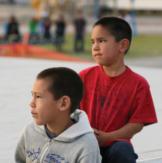










Vote by all Inuvialuit gave COPE the mandate to start Inuvialuit Regional Claim. Arctic Slope Regional Corporation (Alaska) advances loan to COPE.
july 13th - Amendments to proposal
may 13th - Inuvialuit Nunangat Proposal presented to Indian Affairs minister by COPE, followed by 2 months of ‘clarification meetings’. First Volume of Berger report released


COPE prepares serious court action on Aboriginal Title, Meeting between COPE and Minister, Joint Working Group set up.
sept – oct - COPE finds government’s response to Inuvialuit proposal unacceptable








Wallace Goose was a respected elder. He pulled the people together and he made us what we are today. A long time ago, he rallied the people together to start talking about our rights, and in recognition of that, the IRC created an award. The Wallace Goose Award is given annually to a group or an individual that has made a significant contribution to the preservation, promotion or well-being of the Inuvialuit People. – Dwayne Smith (during the opening ceremonies of the 40th Annual Circumpolar Games).∞



Aklavik
Alice Husky
Annie B. Gordon
Nellie Arey;
Paulatuk
Charlie Thrasher

Tony Green
Sachs Harbour
Joey Carpenter, Frank and Martha Kudlak

Tuktoyaktuk



Eddie Gruben
Mark Noksana.
Inuvik
Mrs. Madeline Smith
Mr. Joe Teddy
Mr. and Mrs. Sam Lennie
Inuvik Drummers’ and Dancers’
Mrs. Jessie Colton
Mr. Frank Hansen

Mrs. Verna Firth
Mr. Louie Goose
Mr. William Gruben
Mr. Roy Ipana
Mrs. Anne Kasook
Ms. Shirley Kisoun
Dennie Lennie
Northern Games Boys’ & Mr. Abel Tingmiak
july 14th - Joint Position Paper approved by Cabinet, authorizes Minister to sign AIP with land selections in JPP (all (a) lands and 10,500 sq. mi. of (b) lands around Husky Lakes


85% of remaining (b) lands selected, “overlap” delays the rest. Government wants a fact finder. Overlap agreement with Old Crow torn up by Old Crow. Yukon Government wages media campaign against AIP. Liberal government defeated, new Minister. Conservative government refuses to negotiate, replaced DIAND DM, wanted changes to AIP. Nellie first elected as MLA. New Overlap agreement with Old Crow.
oct 31st - Agreement in Principle signed, advance payments, interim land and hunting provisions start
IDC (interim) started
IGC Started. COPE language project started. New federal negotiator appointed, new arrangement Chief negotiator from outside DIAND
Liberal government returned, new Minister (Munro). NEP legislation introduces “Crown Share” – expropriation of O & G rights, lobby and protect (a) lands from legislation – successful, provision in IFA making Inuvialuit beneficiaries of “Crown Share”







dec 24th - Minister’s letter precipitates breakdown in negotiations, outlines 5 required changes to AIP. Negtotiating process breaks down as COPE see government as lacking credibility. COPE elections turn out Sam Raddi and elect Peter Green as President. COPE legal counsel (Cumming) resigns.
Munro commits to AIP and negotiations



jan – jul; Trying to get negotiations going again.

Munro announces he will open negotiations to IFA.

Simon Reisman appointed as Chief Negotiator, promises final agreement in ‘6 months’. Beaufort Production Plans are announced by Gulf, Dome and Esso. Negotiations begin. New legal counsel engaged (Flavell). Befort Sea Environmental Assessment Review Process starts
feb 28th - Offer made to Reisman for comprehensive package of tradeoffs for IFA. dec -Outstanding issues resolved and signed off in negotiator’s package
Dec; Aide Memoire Reisman travels to Inuvik







Mar 27; Cabinet approval of IFA. May 7 – 28; Ratification voting. June 05 – IFA Signing. Parliamentary legislation, all party agreement passed three readings passed in one day (precedent). Senate approval.
What else happened in 1984?
• The 1984 Summer Olympics were held in Los Angeles.
• MuchMusic became Canada’s answer to MTV.
• The Edmonton Oilers won the Stanley Cup, defeating the New York Islanders 5–2 at Edmonton and ending the Islanders dynasty. It was the first cup in Oilers club history and it was the beginning of a dynasty.
• On June 5th, Cyndi Lauper's "Time After Time" became a #1 hit
• Marc Garneau became the first Canadian in space, aboard the Space Shuttle Challenger.
• Pierre Elliott Trudeau won the Albert Einstein Peace Prize.
• Jeopardy! was relaunched with Alex Trebek as host
Consolidation of changes with AIP, final drafting of IFA. Overlap agreements with D/M.
It is a Friday afternoon in the Inuvik Centennial Library and Dwayne Drescher is hard at work. He is surrounded by old newspapers and he is carefully flipping the pages; searching for pieces of the past.
Drescher has dedicated a large part of his summer to helping the library update their memorial project. The project was established in 2002 when the library received a large donation of funeral programs from Vicki Billingsly and now, years later, the collection has grown to over 350 programs, with more waiting to be added. In recent years, the project lost momentum, but Drescher and head librarian Bev Garven are working on restoring it and bringing it up to date. The pair is also considering an expansion of the project to include surrounding communities.

Drescher spends his days combing through old papers looking for funeral announcements or photos that can be added to the project. Once scanned, the information is added to that person’s file. Anyone is able to contribute to the project, and everyone is encouraged to go in and flip through the pages.
“Inuvik is still young. It is only 50 years old, and now is the time to do the research about our history and its people,” says Drescher. “When we put everything together, we can see how it connects, especially in this town.”

Passionate about the project, Dresher sees the memorial programs as a link to the past. “I found pictures of my uncles and stories of my great grandfather,” explains Drescher. “I never knew that my great grandfather was a carver, and now my brother Greg is into carving and I wonder if I could do any of that. When I look back at the older notices, it really makes me aware of how some of our culture is being lost. I look back and see so many neat things. The language is different in the older ones and you can see how we are becoming more modernized. There are also traditional elements that you can see and I wonder if there is anyone around that can still teach us how to do that.”
In September, Dresher will return to Saskatoon where he is attending the University of Saskatchewan. Although he will be gone, the project will carry on. “There is still decades that we need to go through so we are not even close to being finished,” says Drescher. “There is a lot of history in these books.”∞




For more information on the Memorial Project, please contact the Inuvik Centennial Library: Phone: (867) 777-8620 Fax: 777-8621 e-mail: IK_Library@ gov.nt.ca


 Words
Words
“Hip-Hop is not always seen in the best light,” explains Stephen Leafloor. “We often hear about the negative sides of this music; the drugs and the violence, but the program we run here is a very positive experience. We use the hip-hop to reach out and connect with the youth.” Leafloor (who is usually refered to by his hip-hop name Buddha) has been a social worker for 20 years and is the founder of a program called Blueprint for Life, a social program that combines the art of hip-hip dancing with talks on social issues that are affecting today’s teens. Buddha and his crew of break-dancers have been traveling around Canada spreading inspiration to youth.
On August 23rd, 2009, Youth from around the Inuvialuit Settlement Region were brought to Inuvik to take part in a one-week seminar that ended with a dance battle. Early in the week, the youth were divided into two dance crews and each day they would rehearse routines for the big battle. The dance steps were fast and complicated, but the youth were determined to get it right. “I wasn’t really into hip-hop until the first day ended, then I realized it was really cool,” says Foster Allen, a youth from Inuvik. “I think this is a really positive experience and I love it.”



Although learning the dance moves was challenging, the most difficult part of the day was typically the group discussions, which can get fairly emotional, as they touch on issues such as substance abuse and bullying.
Jon Amos, a participant in the seminar, isn’t frightened of the tough subjects. “It’s all about the positive. If you are angry, do something fun. Take out your anger on the dance moves. This is what this week has taught me,” says Amos. “The positive thing is that Blueprint for Life is helping me get involved with the youth, and it is helping others stay away from drugs and »
alcohol.

Just talking to them and keeping them active is making a difference.”
“I will always remember having fun and making friends,” says Tiana Elias-Kuptana, who came from Tuktoyaktuk to experience something new. “It was really fun. We learned lots of stuff and we had a great time. I hope I can get other people into it.”



The positive messages and stylish dance moves have made their impressions on these young minds. Blueprint for Life encourages the youth to find their own voice, and these voices are thankful. “It made me feel awesome; it made me feel alive,” says Brandon Day, one of the younger participants in the seminar. “Jon Amos told me about this awesome break dancing camp, so I thought I would check it out. I never thought I would be good at break dancing, but they pushed me to do my best.”
“The youth came from all different communities, and now they are all the same community,” says Peggy Day, one of main organizers for the event. “There has been a lot of parent involvement. It was very good to see everyone who came (for the dance battle). I think it is important to keep the youth motivated and excited.” Day has already applied for more funding to keep the program going in all the communities.
Even though Buddha has left the ISR, break dancing may have found a new home. Each participant expressed interest in keeping classes going and working together to create new steps and routines, one of the most keen was Inuvik’s break dancing poster boy Jon Amos. “I want to keep it going,” says Amos. “At least have some people get together a couple times a week to practice.”
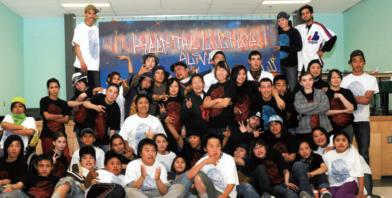

Inspired by moves and the message, Hip hop has now grown some northern roots.∞

Youth from across Canada met in Inuvik August 17th-21st, 2009 to discuss Climate Change. Margret Akoaksion a delegate from Ulukhaktok, says that she has already seen the effect of climate change first hand. “The weather has been strange. One day it snows and the next day it rains. We haven’t really had a summer,” says Akoaksion. “When I get back home, I want to share what I have learned with the community and increase awareness about climate change.” Many other attendees felt the same way and shared their stories. Floods in Nunavut, storms in the Yukon, droughts in the prairies, each story painting a big picture that climate change is a reality we need to address.



“One of the major benefits of having the conference in the north was being able to hear traditional knowledge from the elders and hearing stories of how it used to be and how it has changed,” says Josh Prowse, a law student from Victoria who attended the Climate Change Summit in Inuvik. “Hearing stories about how generations of families would fish on the same rivers but now, because of climate change, those rivers are no longer accessible is really eye-opening. To realize that climate change isn’t a thing in the future but it is something that is already affecting lives today is something pretty powerful.”
Representatives from the three territories and southern Canada came together to create a declaration that they will present to the Canadian Government at Powershift, a climate change conference which is being held in Ottawa, Ontario on October 23-26th, 2009. “The declaration is a good product from an excellent summit,” says Dennis Bevington, the Member of Parliament for the Northwest Territories who attended the youth summit. “I think it is very apropos to have the young leaders from the three territories here together in Inuvik talking about this extremely important issue. It speaks to their desire to come together as northerners. I feel it carries a lot of strength.” Bevington has been an environmental advocate for many years, and has won awards from the Arctic Energy Alliance for his zero emissions office building, which uses solar and biomass energy. Bevington spent the week observing the conference and was very impressed with the results. “Like any action, you have to have a plan of attack to get your message across,” states Bevington. “I’ve seen a lot of work that is going on here to make that happen, and anything that I can do to help, I will be quite willing to do so.”
2009 is a crucial year for talks on climate change. Twelve years ago, the Kyoto Protocol was established,


which states that countries will pledge to reduce their greenhouse gases. At the time, Canada had agreed to reduce their emissions by 6% by 2012 however; many experts say that those targets will not be attained. With time quickly winding down on the Kyoto Protocol, a Conference of the Parties (COP) is being planned for Copenhagen, Denmark for December 7-18th, 2009. Representatives from 192 countries will be present to formalize a new agreement regarding climate change. The new agreement will take effect when the Kyoto Protocol expires in 2012. “Climate change is an incredibly vital and important issue,” states Prowse. “It is necessary that the government take actions to halt climate change. If our government isn’t doing that, it is our responsibility as Canadians to think about that and decide whether our government is doing a good job.”
“I hope that leading up to Copenhagen, along with other young people from across the country, we can make our government listen and build a stronger Canadian position going in to Copenhagen,” says Bevington. “These young people are on the right track and their message is important.”∞
Your footprint is the total amount of greenhouse gas emissions that you directly (or indirectly) cause. We can all take steps to reduce our carbon footprint and here are a few tips:


• Set your thermostat a few degrees lower in the winter and a few degrees higher in the summer to save on heating and cooling costs.
• Walk or bike to work. This saves on gas costs while improving your cardiovascular health and reducing your risk of obesity.
• Buy local meats such as muskox, reindeer or char. Purchasing from local sources also keeps money in the local economy.



• You can make very effective, non-toxic cleaning products whenever you need them. All you need are a few simple ingredients like baking soda, vinegar, lemon, and soap. Making your own cleaning products saves money, time, and packaging.
• Use a reusable water bottle as often as possible. Not only is bottled water expensive, it also generates large amounts of waste.

On august 2009, sixty young canadians gathered in inuvik, northwest territories for a summit on climate change. We are from communities across canada and are united by the magnitude of the climate change crisis, so much so that we were moved to tears by our shared experiences. We call for immediate and coordinated global action, as the world faces no graver threat. we must act now if we are to avoid dire consequences. The only thing that frightens us more than climate change is our governments’ failure to respond to it.
climaT e change is a human issue

our lives have already been altered by the impacts of the climate crisis. climate change has affected our health, our food security and our cultural identities. as northern leader sheila watt-cloutier told us, “climate change is not just an economic story, it’s not just an environmental story, it’s a human story.”
our norT h is highly vulnerable T o climaT e change emissions from around the world have lead to the present-day reality of climate change. The rapid changes we have seen and experienced in the arctic show us how vulnerable the north is. as landscapes change, many animals face the prospect of extinction and those who have contributed the least to climate change are being most affected by it.
climaT e change is happening now
our north is warming, our ice is melting, climate change affects us. The immediacy of the crisis was illustrated in pangnirtung, nunavut in the spring of 2008. erosion and flooding washed out an essential bridge and the community experienced a loss of all water and sanitation services. These families faced the dangers and realities of climate change first-hand.
we musT acT now
it is not too late to prevent further devastation. canada must now be a leader in reducing emissions and motivating the world to act. we also have the responsibility to help vulnerable communities adapt. leaders at all levels must develop and implement policies that will address the climate change crisis. as summit delegate Joel hilchey, 26, stated “we can change the way the world does business. This is our opportunity.”
Photos courtesy of ICS archives

For thousands of years the Inuvialuit have roamed the arctic region in search of food, resources and shelter. Generations have lived off the land and trusted the knowledge passed down from their elders. They have made this land their home, and are proud of their northern history. Although, Inuvialuit are believed to have descended from the Thule people who once lived in the Arctic, the actual history is vague. Where did the Inuvialuit come from and what were their migration patterns? These are questions that the Genographic Project hopes to answer.



National Geographic, along with IBM and the Waitt Family Foundation, has recently commenced a landmark study that will assemble the world’s largest collection of DNA samples, which will be used to map how humans populated the planet.
“It is a project that is designed to study human ancestry and migration across the world,” says Theodore Schurr, an associate professor from the University of Pennsylvania, who has been working with genetics for over 20 years. “In a basic way, it is a genetic genealogy project involving all of humankind, but also in different parts of the world we are using the

information to understand the different communities that have lived in those areas for a long, long time.” Schurr recently traveled to the Inuvialuit Settlement Region to begin collecting samples of local DNA. “We’re using DNA as a tool to understand aspects about migration and ancestry because these DNAs reflect genealogical relationships between people in an unbroken, and unmixed way,” states Schurr.


To better understand the Genographic Project, we must first understand DNA.
DNA, or deoxyribonucleic acid, is in nearly every cell in our bodies. Often referred to as the human blueprint, DNA is passed on from parents to children, and no two »

“We can all work together to illuminate the history of the region, but also shed some light on the history of humans as a global population.”
s x y r x x s x y
organisms (except identical twins) have the same DNA. Many things--the color of our eyes or hair, whether we're tall or short, and our chances of getting certain diseases-depend on the genes we get from our parents.
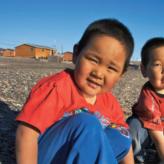

Our DNA is an important tool in understanding a person’s family tree. Nuclear DNA carries information from both your parents, but there are other types of DNA that just come from one parent. Mothers will pass DNA called Mitochondrial DNA to their daughters, that DNA will continue to be passed to all the future daughters on the family tree. Mothers will pass mitochondrial DNA to their sons, but their sons cannot pass the information on to their children. The father will pass
s x y r x x
on a Y-chromosome to their sons, but not daughters. A female cannot have a y-chromosome because the y-chromosome determines that the child will be male.


Keeping that in mind, researchers are able to trace family trees using those two pieces of information. They test the Y-chromosome in the males and the mitochondrial DNA in the woman to find out more about where families have come from. “We are working with hundreds of thousands of participants across the world,” says Schurr. “We can all work together to illuminate the history of the region, but also shed some light on the history of humans as a global population.”
Getting DNA from a person is a painless process. If
Fathers pass on Y-chromosome to their sons. Fathers can not pass on Y-chromosome to their daughters.you have ever watched crime shows like CSI, then you know that we leave DNA everywhere we go. It is present in hair that we shed, and in our skin cells. Since every cell in our body has DNA, for this project all they ask for is a swab from the inside of our cheek, which is about as trouble-free as brushing your teeth. From one swab, researchers will be able to trace one side of a person’s family tree, and potentially trace where they came from, depending on common links they may find with other cultures in other parts of the world.
Although the project will take at least 5 years to complete, the participants can expect their results much sooner. “Each participant will get a copy of their results,
and that should be in the mail by November,” guarantees Schurr. Each participant is given a secret code and their name will not appear in the results, so the whole process is confidential.
It is hard to think that the Inuvialuit could come from anywhere else but the North, but scientists believe that all human species ultimately trace back to Africa. Over tens of thousands of years, people have migrated and adapted to their surroundings. Preliminary research shows that the Inuvialuit may have some multi-cultural roots. “Through this process, we can trace steps back to Asia and Northern Eurasia,” says Schurr. “That is where we will find roots somewhere between Mongolia and »

+
“We are interested in learning more about the Inuvialuit and Inuit populations across the arctic,” says Schurr. “Where their origins lay, how long ago they expanded into the North, and the dynamics it created with all their moving back and forth across the arctic. We will look at as much evidence as we can, in both the historical and prehistoric dimension, to try to tell the story the best we can.”

The Genographic Project will be working directly with the Inuvialuit Regional Corporation, as well as the



Gwichin Tribal Council to see what we can do together to piece the puzzle together. “We will use all the expertise that people have about the language history, the cultural history and the archeological history,” says Schurr. “It is critical information for us to know.”
“Each new analysis adds a new view of the questions we’ve been trying to answer for years. In some ways, it provides new answers; we are refining what we know,” states Schurr. “What we do know is that the story of the people of the Americas is not finished and as we learn more about human DNA, we are going to add a new
understanding about the initial settlement of the Americas, and what happened once people were here. We never know what we will find until we finally piece together all the pieces.”
Its been often said that we live in a small world, yet sometimes it is possible to feel so disconnected from everything. With a study like this, it will easy to see how we are all connected and how we are all members of one race.∞






Once again, July marked the return of the Great Northern Arts Festival. Painters, carvers and artists returned to Inuvik to exhibit their newest pieces and hold workshops for art enthusiasts.
 by Maia Lepage
Photos by Shayne Cockney and Maia Lepage
by Maia Lepage
Photos by Shayne Cockney and Maia Lepage
For 10 days, creativity is found in every inch of the Midnight Sun Recreation Complex. The curling rink is transformed into a gallery to present art to the community. In the middle of gallery, tables are set up for the artists to work and chat while the public watches on. The skating rink is transformed into a studio where other artists can do larger projects, and hold workshops. Behind the arena, giant white tents are set up so that carvers could do what they do best, without the worries of having to clean an indoor workstation. Drills, sanders and saws echo from morning till night, while normal rocks are transformed into beautiful art, ready to be sold in the gallery. The whole festival is a work of art within itself.
The festival first started as a showcase of northern art in 1989, and has now grown into a world-class affair. Artists and visitors of all ages, from all reaches of the globe gather in Inuvik to be a part of this event. The theme for 2009 is Old Legends, New Dreams, which is reflected in the art that surrounds the gallery. Traditional art is showcased next to modern art, and everything compliments the beauty that the north has to offer.
The relaxed feel of the festival is something that everyone can agree on. Simon Tookoome has been traveling from Baker Lake, Nunavut to the festival for the past 19 years. An artist and a carver, Tookoome spends his time in the tents behind the arena carving with friends. “I have been carving a long time, but I do not carve as much as I used to,” states Tookoome, as Ame Papatsie, an artist from Pangnirtung, translates for him. The atmosphere created by the artists is welcoming and even though artists are selling their work in the gallery, there is no sense that they are competing against each other. They are all smiles while they help each other work on projects.
“My favorite part of the festival is meeting all the artists every year,” says Maryanne Taylor, an artist from Tuktoyaktuk. “It is like family coming home.” Taylor has been participating in the festival for 12 years, and has seen the same faces return year after year. Although Taylor says that carving is mostly a hobby, her pieces are amazing. She has recently been chosen to represent northern artists at the 2010 Olympic games in Vancouver. “I feel excited and nervous. I don’t really know anything yet. I just know I was chosen,” says Taylor, as she cheerfully smiles. »
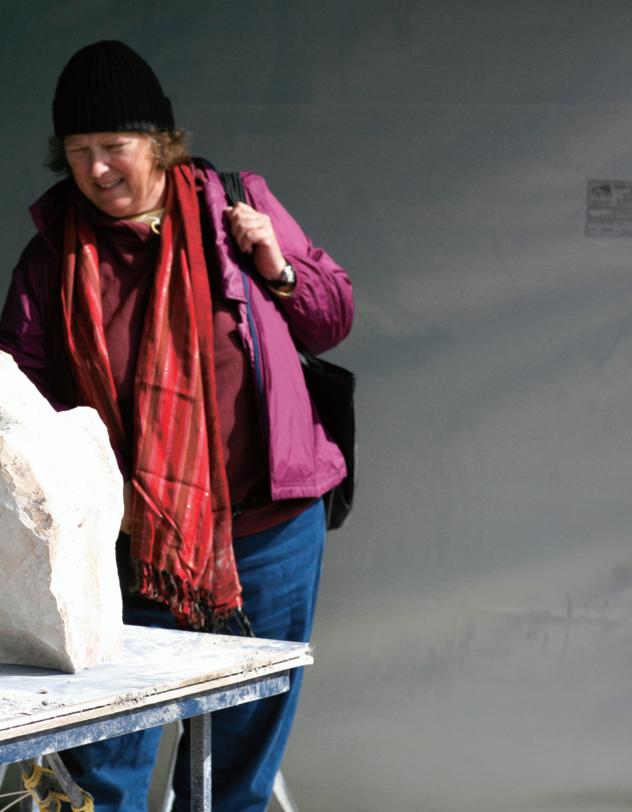
Raquel Nuttall from Inuvik is one of the North’s most promising new carvers and has been around the festival since 2001. “The Festival has changed quite a bit,” says Nuttall. “It has its ups and downs. Sometimes there are a lot of people; sometimes there's not. Either way, it is an extremely great festival. We have a lot of artists and a lot of people from all over Canada that to come together and share their art.” Cherly Kaglik, a painter from Inuvik agrees. “I’ve been mostly volunteering this year and helping out where ever they need me,” says Kaglik. “The festival provides a place where artists can interact and we can learn from each other. It feels like we’ve just »











been hanging out.”
In the few past years, the festival has gone through a lot of changes. They have doubled the size of the gallery and made changes to the layout of the festival. A lot of work has also gone into creating new and exciting workshops. “We have done a lot of infrastructure and bought new display cases. We have also purchased a 45-foot semi trailer for storage,” says Tony Devlin, the executive director of the festival. “These are things that the public may not see, but they make the organization more efficient. This year, we’ve worked really hard to make the program much more interesting. We’ve invested a lot more time, money and effort to bring in things like the ArtCirq.”
The ArctCirq was definitely a highlight of the 2009 festival. Flown in from Igloolik, Nunavut, the ArtCirq provided audiences with three sold out performances of music and acrobatics. Crowds held their breath as members of the circus performed death-defying routines while musicians played calm melodies in the background. The Artcirq is a truly amazing visual experience, and it is distinctively northern. Dressed in amautis, the group combines traditional elements with exciting balancing acts, which often seem impossible. Back flips, human pyramids and juggling acts command cheers and applause from the audience. The time, money and effort that Devlin and his team invested were definitely appreciated by the masses that we mesmerized by the highflying routines preformed by the Artcirq.

Other highlights included a multicultural performance by Rik Leaf and the Tribe of One, which combine folk music, spoken word poetry, Aboriginal dancers and live-action painting; an old time dance that featured the musical stylings of James Rogers and the Good Time Delta Band; and the annual GNAF Arctic Fashion Show.
With the success of 2009 festival, preparations have already begun on the 2010 Great Northern Arts Festival. “We can always grow bigger and better. Next year I am hoping to bring in artists from Russia and Greenland, but that is not written in stone yet,” says Devlin. “We are also intending on creating a very informal off-season workshop series here in Inuvik. We want this to be more than a 10-day festival. We would like to contribute to the art and culture of the area on a regular basis.”
The artists clean their stations and pack their tools as the 2009 festival ends. Many homes have new artwork proudly on display and friends, new and old, say their goodbyes and exchange hugs. The festivities may be over for another year, but celebration of this year’s festival will last for a long while.∞



 Words by Rachel Hansen with Photos by Rachel Hansen and Jean-François Bisaillon
Words by Rachel Hansen with Photos by Rachel Hansen and Jean-François Bisaillon
This was something I imagined doing since I started working for Parks Canada. As part of the Parks Canada communication team in the western arctic, I work with our photo collection almost daily. Three years of sorting through pictures of the Firth River made me think that rafting it would be an amazing adventure. So when the opportunity knocked, I swung open the door and embraced it!
Every year, twice a season, a group of Parks Canada staff patrols the Firth River in Ivvavik National Park. We assess the river in the beginning of the season for natural and wildlife hazards to ensure the safety of visitors. At the end of the summer, we monitor the conditions of the campsites after a season of use.

There were five in our group: Jean-François Bisaillon and Pierre Marchand, resource conservation specialists, Nelson Perry, the ecosystem scientist, Shane Goeson, an ecosystem technician and myself, a heritage interpreter. For me it was a key opportunity. I work with visitors and to experience the river will help me a great deal when answering visitor’s questions or presenting park orientations. Shane and I were the only beneficiaries on the trip and that was special for many reasons. This year marks the 25th anniversary of the IFA and of Ivvavik National Park. It was a good time to experience and connect to a place where our ancestors walked, hunted and fished that we now protect.
Our trip started on an early Wednesday morning, when we were ready to board the Twin Otter. I had been so excited before that it was only then that the jitters hit me. I was about to raft a world-class white-water river with no rafting experience whatsoever. I did not have to think about it too long, though. My group of trained swift water rescue co-workers were eager to pass on their expertise, so on our second day, we got in our dry suits
and did a crash course in swift water rescue. What an experience! I will never forget standing on the rock starring into the water. I had to jump. Everyone was waiting for me, but I couldn’t. I watched one after the other jumping and it looked so easy. They looked like seals jumping in the arctic waters. I still can’t quite believe that I did it! I jumped in the mighty Firth and swam for dear life to shore. The water was so cold that when it splashed on my face, it took my breath away. After a few times of jumping in, I started having fun. Together with the others I practiced how to swim offensively, defensively and how to avoid hazards in the water.
For those reading, you may or may not have whitewater rafted before. If you haven’t, you will certainly learn new terms when you do it. You may learn that you should tap your head if you are okay, or that rapids have classes. One term that I will never forget is “high side”. When you hear the term high side, you have to put all your weight on the high side of the raft so it doesn’t tip. If you tip the raft, everything and everyone falls in the freezing water. Not long after our training, we got to unforgettable Wrap Rock. Everything had been going smooth when a big rapid pushed us towards the rock and shoved us up against it. Our raft went almost vertical to the rock wall with water half way up the side. I heard ‘high side’ and held on with all that I had. Our raft did not tip and I did not fall in the water, but others were not so lucky. It was only when I could breathe again that I looked beside us to see Pierre in the water with one hand above his head holding his video camera and swimming calmly to shore. I would never have thought that swift water rescue training would come in handy just a couple hours after we took it. It was an exciting way to start the trip.

The Firth River rapids can rate from a Class I to a Class V - easy to very difficult. Before some rapids we often had to go to shore and hike along the ridge to scout out a good



“I couldn’t believe I was going! The night before we left, I felt like a child on Christmas Eve. I couldn’t go to sleep. I kept thinking… It’s for real, I’m going to raft the Firth!”
line to raft. I thought to myself several times “what did I get myself into?” Some rapids looked so frightening that I wanted to get out and walk along the ridge. Instead, I would tell myself that I had gotten this far and I couldn’t back down... and I kept going.



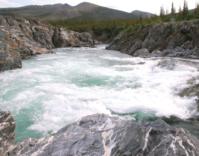

During the eight days I felt like the luckiest person in the world. I was rafting the Firth River and this was my job! This was, by far, the most amazing trip of my life. I have often wished to travel the world and see different places, but after the Firth trip, I figured that I could discover many treasures in my own homeland. The Firth River provides a natural corridor for a rich variety of wildlife and for park visitors who want to see the diverse


arctic landscape. For me it provided experiences and a lifetime of memories. In the past, if someone asked me what true beauty was, I wouldn’t know what to say. Now I know that Ivvavik is an obvious definition.∞
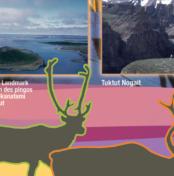








Rachel grew up in Inuvik where she was always out on the land with her father. Being out on the land is where she felt the most comfortable and enjoyed it. After completing high school and a year of college, she found herself working at a job that she loves. She has been working for Parks Canada for three years as a heritage interpreter in the Western Arctic. She is a proud Inuvialuit beneficiary, a wife, a mother of two, and now a rafting enthusiast.







 LEFT TO RIGHT - Near the end at Nunaluk Spit it was inevitable for Rachel to fall in the water. Rachel with her Dolly Varden Char at Anticline campsite. Anticline with turquoise water. Rachel in dry suit at Upper Sluice Box. Rapids at Sheep Slot
LEFT TO RIGHT - Near the end at Nunaluk Spit it was inevitable for Rachel to fall in the water. Rachel with her Dolly Varden Char at Anticline campsite. Anticline with turquoise water. Rachel in dry suit at Upper Sluice Box. Rapids at Sheep Slot










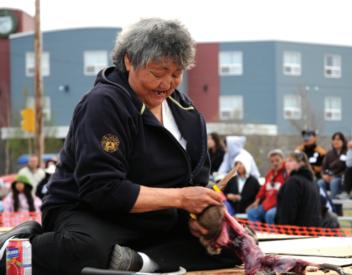




 Words and photos by Maia Lepage and Ryan Lepage
Words and photos by Maia Lepage and Ryan Lepage


Over the past 40 years, the circumpolar games have evolved into a northern institution. “We have participants from Iqaluit all the way to Alaska,” says Edward Lennie, chairperson and founder of the games. “When they land here, or wherever the games are held, no one is a stranger.”

Some of the athletes like Roy Ipana have been participating in the games since their conception in 1969; other athletes like Stacy Beights are just beginning. “I watched the Northern Games demonstrations at the Arctic Winter Games,” says Beights. “I admired the sportsmanship they demonstrate and I just want to be a part of it.” Beights traveled from her home in Yellowknife to be part of this year’s games and with the help and support of other athletes, did very well. “So many people were helping me out, and teaching me about the games. It was a huge help,” says Beights, who placed first in both the 1-foot and 2-foot high kick.
“I think it is awesome,” says Gerry Kisoun, a veteran of the games. “It is a great way for us to showcase our












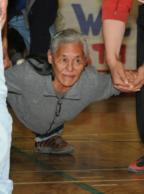









culture and share it with the people that are out there.” Floyd Roland, the Premier of the Northwest Territories couldn’t attend the games year, but he agrees whole heartily. “For 40 years, athletes, volunteers and representatives from the circumpolar north have come together for this annual event,” says Roland. “The games were once played for practical purposes; to build strength and ensure

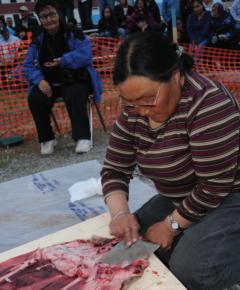






survival. They have come to be recognized around the world as a symbol of North and its people. The endurance, and the drive that these games demand are a reflection the endurance and drive of all Northerners.”



Tim Angotingoar, from Iqaluit has been competing in the games for many years. “I went to my first northern games 31 years go. It was something different and something I’d never seen. It is part of our heritage,” says Angotingoar. “I think these are the greatest events that can be held anywhere in the world.”


The world will have another opportunity to see the games this February at the 2010 Olympics. Abel Tingmiak and Edward Lennie have already been chosen to represent the games as part of an Olympic demonstration, and eight more athletes will be chosen from this year’s games to accompany them. Matthew Anikina from Tuktoyaktuk hopes to be one of those athletes. Anikina competed in 8 events this year, and »



“It all started with the first arctic winter games,” recalls Edward Lennie. “In 1969, I heard an announcement on the radio. We heard that the winter games were going to be held in Yellowknife. The name ‘Arctic Winter Games’ bothered me. I thought ‘how could they call something the Arctic Winter Games when they have nothing from the arctic?’ I went to see Rev. Dietrich, who was a minister here, and Nellie Cournoyea was there too. Nellie told me that I should play the games and she was right. We started to pass on the games to some of the young people.”
Right before the winter games, Lennie assembled a group of young men and they started training. “The original northern games boys are still all here. People like Abel Tingmiak and Roy Ipana,” remembers Lennie. “When we got to Yellowknife for the games, we couldn’t compete. They didn’t know what our games were; we were the only ones who did. So we did a few demonstrations.”

At the time, Prime Minister Pierre Trudeau was in Yellowknife for the games. “We were asked to do a demonstration for Trudeau, so we did,” says Lennie. “The day he was supposed to leave, someone tapped me on the shoulder and asked if we could demonstrate the games one more time for the Prime Minister.”
Lennie and his team started looking for a place where they could hold a demonstration for Trudeau, but all the spaces were occupied. “We were looking at a curling rink, when I saw some plywood outside,” remembers Lennie. “We went over and looked at the pallets and I told him that if he really wanted to see the games again, we could demonstrate out here, on the pallets. I asked the boys to help me spread out the pallets and we did our demonstration right there. From then on, it grew just like a flower. It carried itself away and now it has roots all over.”
“At the time, I never thought it would get this big,” says Lennie. “I passed the games on to a few people like Gerry Kisoun, Tommy Smith, Roy Ipana and Abel Tingmiak, and they carried it on.” Lennie supports his students every effort. “Anytime they needed permission, they would call me,” recalls Lennie. “Even if it was 2am, they would ask me how we used to play games. I would wake up and teach them. They would do the rest of the games after that.”
“To tell you the truth, right now I can honestly say that I am a very proud person in Inuvik. After seeing all these young people here; seeing my grandchildren participating. They are all in it, they are taking care of it and I don’t have to worry about the games being lost again.”




Edward Lennie is the father of the Northern Games and his contributions to the game will not soon be forgotten.

won 5 medals. “These are the best games in the world. I love competing,” says Anikina. “Hopefully, I’ll be chosen to go to Vancouver for the Olympics. I want to travel and see all my friends again.” The names of the chosen athlete’s will be announced at the end of September.
Years from now when we look at the records of the 2009 Circumpolar games, we will see that Tootoo Tanuyak broke the record for the 1-foot high kick by reaching a height of 9 feet, and that Marion Tautuk Green raised the bar in the senior female swing kick when she reached a height of 4’2. We will see the strength and determination of many athletes. What we will not see in those results are the friendships that were formed and the memories that will last a lifetime. The games bring together friends and family; they represent the spirit of unity of the north.∞
















Best Plucked Senior Male: Kelly Ruben, Paulatuk
Best Plucked Senior Female: Jean Gruben,Tuk, Jennifer Thrasher
Best Plucked Senior Male: Kelly Ruben, Paulatuk
Best Plucked Senior Female: Jean Gruben,Tuk, Jennifer Thrasher



















This summer, as part of a youth mentoring program, two students from Tuktoyaktuk, Jocelyn Noksana and Ryan Walker, participated at the beluga camp.

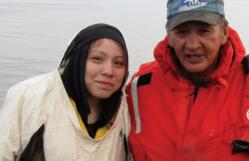

Students helped scientists’ sample tissues to measure contaminants and diseases as well as spend time with elders on the island and visiting the island to learn about traditional skills. Beluga whales hunted in near Tuktoyaktuk are taken to Hendrickson Island where a sampling team made up of elders, scientists, youth, and


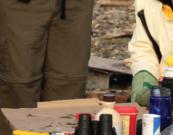



community monitors collect information along with tissues to learn about belugas and their health. Given some of the current and anticipated stressors such as climate change, researchers, together with community, are trying to better understand beluga health to help insure the future of this population and the continued traditional use.


This summer, as part of a youth program, I was fortunate to be a field assistant at the Hendrickson Island beluga whale camp. During the summer, I helped scientists sample beluga whales. I worked closely with Lisa Loseto, a researcher from the University of Victoria and also Fisheries and Oceans Canada; Stephen Raverty, who is a veterinarian with British Columbia Animal Health; and a graduate student named Marie Noel from the University of Victoria. They are all interested in the health of this beluga whale population; which is known as the eastern Beaufort Sea beluga population. Together, we sampled blood, blubber, liver, kidney, heart, and other organs from the inside of the whale to measure contaminants and diseases whale may have. It was a really fun experience for me because I was able to learn a lot from them. It also made me think of other things I can do in the future if business is not the right career path for me.
As part of my student project on the island, I also had the wonderful opportunity to work with the whale monitors, and Frank and Nellie Pokiak who have now been sampling beluga whales in partnership with the DFO on Hendrickson Island for the past 10 years. Sampling beluga whales is a real team effort and everybody (Frank and Nellie, the scientists, the whale monitor and the hunters) worked together. Both Frank and Nellie know a lot of traditional skills and they used them while we were on the island. For example, they set nets, which we checked for fish that they later smoked. I also joined Frank, his daughter Verna, and his grandson Anthony on a boat ride to Whitefish, to get snow for water. Both Nellie and Frank think that it is important for traditional knowledge and science to work together because they both have different approaches that may reach similar answers.
Frank and Nellie work together as a team along with the monitor’s and scientists. Frank helps the hunter butcher the whale and takes samples for Nellie, who stores them in the freezer. Nellie does all the traditional cooking at her camp along with keeping it organized. She also helps write reports about the whales. I had the opportunity to talk to Nellie about being on the island and being involved in this work and she shared some interesting things. She told me about how things are changing, like the landscape. She also said that the whales are starting to have their young earlier. Nellie believes that it is important to continue working with these animals because it helps to sustain the population of the belugas.
Working with Frank was also fun! When we got the first female whale, Frank had told me that I had to get the milk; he said I had to get onto my knees and suck the milk out of the whale! I believed Frank and as I started to kneel down, and everyone started laughing. I was so embarrassed because I believed him, but he was only joking.
I had an amazing time out on the island with everyone
and I hope I can do it again some time in the future. I really did learn a lot and I gained a lot of experience. I, myself, believe that this is very important because my people, the Inuvialuit, will keep hunting these animals. It is our traditional food. The oil, gas & climate are only factors. We will always harvest whales as long as they are healthy.
From Tuktoyaktuk. She is currently beginning her first year of college in Yellowknife where she is taking Business Administration.
When you ask most people what they did over the summer, some will tell you they relaxed and enjoyed the weather, others tell you they worked over the summer. Very few can say that they had the opportunity to sample beluga whales with three researchers on an island for a month.
This summer, I had the opportunity to assist three researchers during the Hendrickson Island Beluga Whale Project. During this time, I had a chance do and learn many things. I assisted veterinary pathologist, Stephen Raverty, in the necropsy of the beluga. This consists of taking samples of various organs such as the lungs, liver, etc. During the necropsy, we would look for abnormalities such as skin lesions. Assisting Dr. Raverty prepared and enabled me to perform the necropsy by myself when Stephen had to leave the island. Once the necropsy was complete, I would help Marie Noel, to sample the blood after she had collected it during the necropsy. The blood has to be spun in order to separate the different parts of the blood and enable Marie to sample the parts she was interested in.
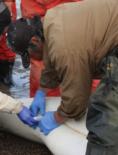
Overall, the Hendrickson Island project was an experience of a lifetime, and I was very fortunate to take part in it twice. Not only did the project give me the opportunity to gain a massive amount of knowledge on the anatomy of a whale and information about contaminants in the Arctic, but also it enabled me to learn a lot about the harvesting and preparation from various hunters from Tuktoyaktuk. I learned everything from pulling in the whale the right way to how to cut off the perfect piece of Muktuk. Not only do I feel that this project provided me with a large amount of knowledge and information, but this project, once complete, will provide vital information on the beluga whale population to the residents of the Inuvialuit Settlement Region.∞
RyanWalker,18

is also from Tuktoyaktuk. He has just started his first year at the St Francis Xavier University, where he studies science and math.
For more information please contact: Rebecca Pokiak (rebeccapokiak@hotmail.com) or Lisa Loseto (Lisa.Loseto@ dfo-mpo.gc.ca)
It has been said the music is the universal language. Feelings and emotions that cannot be spoken in words can be conveyed through song. Even on the darkest days, hearing a familiar tune can lift the clouds. A talented singer/songwriter, Leanne Goose is well aware of music’s ability to touch the soul.
Singer/Songwriter/ Guitar





leanne was born and raised in the MacKenzie Delta, Northwest Territories, from the banks of the MacKenzie River in the heart of the Canadian Western arctic. This Inuvialuit/Dene singer/song-writer made her migration from singing in the land of ice and snow to the big lights of the city with her debut album anywhere, released in May 2008. Her blend of rock, country & blues is a reflection of her northern soul. leanne has been working to improve her skills as an artist and is very proud to present this workshop series back home.
leanne was nominated for Best Classic Rock album at the Indian Summer Music awards 2009, Best Rock and album Cover Design here at the 2008 Canadian aboriginal Music awards and Best Rock album at the aboriginal Peoples Choice Music awards. www.leannegoose.com

Her songs, which are co-written with her long time partner Laurie McNabb (who also plays guitar), reflect her background and her connection to the North. “I had the opportunity to record my first album about two years ago and I just released it last May,” recalls Goose, “It is quite an accomplishment for me to look back and think about where I came from. I grew up here (in Aklavik). My Grammy and Daduk hunted and trapped all through the area; my family grew up here. It is quite an amazing experience to think I came from here. I lived in a plywood house with no running water and now I have the chance travel and with wonderful people.”
In August, Leanne gathered up a group of her wonderfully talented friends and came back to the north to hold free workshops for northern artists. The first
workshop was held in Inuvik at the Inuvik Youth Centre August 22nd-August 24th, then the group traveled to Aklavik for a one-day workshop on August 25th. workshop, participants were given the opportunity to record their own songs. “I wanted those people who are interested in performing to see what it was like to have a studio experience,” said Goose. “We do our best to recreate what it is like to work with a producer and arrange songs. Even hearing your own voice recorded and played back to you is a valuable tool.” Jason Gordon, a record producer and studio owner from Studio 11 Winnipeg, made his first trek to the north as part of Leanne’s workshop. “Being able to inspire kids and have them get excited about something is a wonderful experience,” said Gordon.

“I have a teenager and I’ve been a teenager so I know how important it is to help young people with music,” states Tracy Bone, a singer/songwriter from »

Singer/Songwriter/ Guitar









laurie has played with many greats in his time. laurie works with leanne Goose, JC Campbell, Tracy Bone, Darren lavallee, to name a few. He is in constant demand for his take on the guitar. He has been playing music and writing songs for over 25 years. laurie wrote and recorded Delta flood back in 2000 and most recently leanne Goose’s "anywhere" album features laurie’s talents writing, guitar and bass guitar work.
laurie started out playing guitar in his hometown of fredericton, New Brunswick. at 18 while in college he was offered to play with a band way up north and ended up in Inuvik, NWT playing rock, gospel and traditional fiddle tunes. laurie is now touring and performing across Canada and the US. www.leannegoose.com
Tracy Bone's primary instrument is her heartfelt vocals. With humble beginnings in Winnipeg, Manitoba and on the Keeseekoowenin Ojibway first Nation. She has been writing her own material since the birth of her third daughter which she says was her inspiration. aside from earning the respect from her peers for her artistry, Tracy is a committed mother to five children.
Two of whom she is a step-mother with partner JC Campbell. Her music can be described as influenced by classic country and pop/rock with unique rich vocals and her own harmonies. Musical accomplishments include: - 2009 Juno awards – Nominee
aboriginal album of the Year - 2009 North american Indigenous Image awards – Win – Best Country CD - 2008 Western Canadian Music awards –Win – Outstanding aboriginal Recording - 2008 Native american Music awards.

Winnipeg, who also accompanied Goose to Inuvik and Aklavik for the workshops. “I wanted to give somewhere for the kids to go to and ask questions about the music business. Give them a way to get started.”





“Being able to make a difference with some of these kids is incredible,” adds JC Campbell; an up and coming singer/songwriter also from Winnipeg.
“The kids up here are a lot more appreciative and a lot more respectful,” says Kevin Radomsky, a Juno Award winning drummer and percussionist. “ They put their heart and soul in the music. Music transcends all languages, all religions, everything. It doesn’t matter where you go in the world; drums are drums, a melody is a melody and music is music. So often you jam with people without speaking a language and by the end of it, you are best friends. It is such a positive experience.”
“Going to Aklavik was kind of surreal,” reveals Goose. “Being in the place where I started and being in a position to present workshops and teach in my own hometown was incredible. I was able to bring in Tracy, JC, Jason, Kevin and Laurie and work in the community. There were so many talented people (from the communities) that came and they were all eager to learn. It was a very rewarding experience. I believe so much in the talent here in the north that I wish we would have had more time to record way more people.”
As a musician, Leanne Goose knows how music can touch the soul. By combining her love of music and her love of the North, Leanne was able to touch the lives of all that participated.∞


Singer/Songwriter/ Guitar








James "J.C." Campbell is of Cree/Ojibway and European decent. This Native Canadian Winnipeg born Singer/Songwriter's smoky pipes are reminiscent of the Bluesmen of past. J.C.'s soulful vocals ring honesty. J.C.’s humble nature adds to the intrigue, that few artists embody. "lazy James" album has 10 original tracks some of which he cowrote with his fiancé and fellow artist, Tracy Bone. Real love has brought J.C. new life, and inspiration to "Keep On Tryin'".

The songs JC writes are reflect his experiences on the hard road of life, realization and personal awakening. In 2007 good "fortune" led him to co-write with Nashville Hit Songwriter and Chief Creative Officer of Ole' Music Publishing Gilles Godard, who has written hits for Terry Clark, Patty loveless and Tracy Byrd to name a few. Captivating audiences with his live performances, he has been humbly compared to Johnny Cash for the aura he radiates. J.C. Campbell music is as refreshing as it is unique. www.myspace.com/campbelljc


Percussion






Radomsky is a Juno award winning drummer/percussionist who has toured recorded with some of Canada's best recording artists, including Harlequin fist. Most recently Kevin played drums fellow Juno award winners Eagle & Hawk the Winnipeg Symphony Orchestra. summer Kevin will be doing a few shows Canada's newest country sensation Higgins”.
well as juggling a professional performers when Kevin is in Winnipeg he is private teacher and clinician who has for over 20 years and has also been the St. James School Div. for the last done many clinics and workshops throughWinnipeg and Manitoba and has been fortunate several students go on to be professional Musicians and Instructors themselves.
www.myspace.com/tracybone
Additional Information:


SPONSORS: Canadian North, GNWTIndustry, Tourism & Investment, NWT Arts Council, Nova Inns-Inuvik, Inuvialuit

















Gordon

Studio Owner Studio 11, Winnipeg, MB
Gordon, Studio Owner and Record Producer. Jason has been producing artists recording albums for over 10 years. He himself, been playing music for over years, mastering all instruments and all Jason works with bands and artists daily basis helping to arrange songs, coaching to get the best sounding performances with everyone he works with.
Jason is actively involved with promotand helping new artists get started. studio holds song-writing contraining workshops and is active in the industry. Jason and his studio have worked with many greats such as Kanye West, Jet Set Satellite, Drive, Steeple Chaser and the list goes on. www.studio11audio.com/pro.html

1.5 lbs of muskox striploin
Yellow pepper
Red pepper
Orange pepper
Carrots
Onion
Broccoli
Tin of Water Chestnuts
1 tbs oil
¼ cup cold chicken stock
2 tbs Soy Sauce
1 tbs Corn Starch
• Slice striploin into thin strips. Cut vegetables for stirfry
• Heat 1 tbs of oil in pan until hot. Add meat. When meat is half cooked, add sliced vegetables and cook until ¾ done.
• While meat is cooking mix cold chicken stock, soy sauce and corn starch until it forms slurry. When meat and vegetables are ¾ cooked, mix in sauce mixture and finish cooking. Season with salt and pepper if desired.
• Serve over a bed of rice.



















